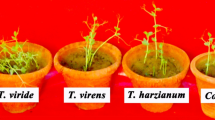Abstract
White mould disease leads to production of sclerotia, which subsequently survive in soil and may be responsible for future epidemics. The effect of the mycoparasite Coniothyrium minitans in decreasing survival of sclerotia of Sclerotinia sclerotiorum was studied. Infection of sclerotia of S. sclerotiorum by C. minitans can be achieved by a single conidium. Under optimal conditions, 2 conidia per sclerotium produced 63% of the maximum infection (ca. 90%) of sclerotia produced by up to 1000 conidia. Similar results were observed on the infection of stem pieces infected by S. sclerotiorum. In field trials, application of conidial suspensions of C. minitans to a bean crop soon after white mould outbreak led to a higher percentage of sclerotial infection than later applications. Ninety per cent infection of sclerotia was obtained within 3 weeks of application by C. minitans suspensions in the range of 5 × 105 and 5 × 106 conidia ml−1 at 1000 l ha−1. The concentration of the conidial suspensions and the isolate used were of less importance. The result was marginally affected by the germinability of the conidia (75% against 61% infected sclerotia at 91% and 16% viability of isolate IVT1, respectively). Less apothecia of S. sclerotiorum developed in soil samples collected after 2 months from plots sprayed immediately after disease outbreak than from those treated 11–18 days later. It is concluded that a suspension of 106 conidia ml−1 in 1000 l ha−1 (= 1012 conidia ha−1) sprayed immediately after the first symptoms of disease are observed, results in > 90% infection of sclerotia of S. sclerotiorum. The infection of sclerotia, which prevents their carry-over, occurs within a broad range of inoculum quality.
Similar content being viewed by others
References
Adams PB (1990) The potential of mycoparasites for biological control of plant diseases. Annual Review of Phytopathology 28: 59-72
Adams PB and Ayers WA (1981) Sporidesmium sclerotivorum: Distribution and function in natural biological control of sclerotial fungi. Phytopathology 71: 90-93
Bourdôt GW, Saville DJ, Hurrell GA, Harvey IC and de Jong MD (2000) Risk analysis of Sclerotinia sclerotiorum for biological control of Cirsium arvense in pasture: Sclerotium survival. Biocontrol Science and Technology 10: 411-425
Budge SP, McQuilken MP, Fenlon JS and Whipps JM (1995) Use of Coniothyrium minitans and Gliocladium virens for biological control of Sclerotinia sclerotiorum in glasshouse lettuce. Biological Control 5: 513-522
Gerlagh M, Whipps JM, Budge SP and Goossen-van de Geijn HM (1996) Efficiency of isolates of Coniothyrium minitans as mycoparasites of Sclerotinia sclerotiorum, Sclerotium cepivorum and Botrytis cinerea on tomato stem pieces. European Journal of Plant Pathology 102: 787-793
Gerlagh M, Goossen-van de Geijn HM, Fokkema NJ and Vereijken PFG (1999) Long-term biosanitation by application of Coniothyrium minitans on Sclerotinia sclerotiorum-infected crops. Phytopathology 89: 141-147
GENSTAT 5 Committee (1993) GENSTAT 5 Reference Manual, R.W. Payne (Chairman) and P.W. Lane (Secretary), Oxford: Clarendon Press
GENSTAT 5 Committee (1997) GENSTAT 5, Release 4.1. Reference Manual Supplement, R.W. Payne (Chairman) and P.W. Lane (Secretary), Oxford, Numerical Algorithms Group
Hedke K and von Tiedemann A (1999) Erste Ergebnisse des grossflächigen Einsatzes von CONTANS® (Coniothyrium minitans) zur biologischen Sclerotinia-Bekämpfung im Raps unter Praxisbedingungen. Phytomedizin 29(4): 24-25
Huang HC, Bremer E, Hynes RK and Erickson RS (2000) Foliar application of fungal biocontrol agents for the control of white mold of dry bean caused by Sclerotinia sclerotiorum. Biological Control 18: 270-276
Johnson KB (1994) Dose-response relationships and inundative biological control. Phytopathology 84: 780-784
McCullagh P and Nelder JA (1989) Generalized Linear Models, 2nd edn, Chapman and Hall, London
McLaren DL, Huang HC and Rimmer SR (1996) Control of apothecial production of Sclerotinia sclerotiorum by Coniothyrium minitans and Talaromyces flavus. Plant Disease 80: 1373-1378
McQuilken MP and Whipps JM (1995) Production, survival and evaluation of solid-substrate inocula of Coniothyrium minitans against Sclerotinia sclerotiorum. European Journal of Plant Pathology 101: 101-110
McQuilken MP, Budge SP and Whipps JM (1997) Biological control of Sclerotinia sclerotiorum by film-coating Coniothyrium minitans on to sunflower seed and sclerotia. Plant Pathology 46: 919-929
McQuilken MP, Mitchell SJ, Budge SP, Whipps JM, Fenlon JS and Archer SA (1995) Effect of Coniothyrium minitans on sclerotial survival and apothecial production of Sclerotinia sclerotiorum in field-grown oilseed rape. Plant Pathology 44: 883-896
Tu JC (1999) Effect of temperature and moisture on the destruction of sclerotia of Sclerotinia sclerotiorum by Coniothyrium minitans. Mededelingen Faculteit Landbouwwetenschappen Universiteit Gent 64/3b: 411-417
Whipps JM and Budge SP (1990) Screening for sclerotial mycoparasites of Sclerotinia sclerotiorum. Mycological Research 94: 607-612
Whipps JM and Gerlagh M (1992) Biology of Coniothyrium minitans and its potential for use in disease biocontrol. Mycological Research 96: 897-907
Whipps JM and Lumsden RD (2001) Commercial use of fungi as plant disease biocontrol agents: Status and prospects. In: Butt T, Jackson C and Magan N (eds), Fungal Biocontrol Agents-Progress, Problems and Potential (pp 9-22), CAB International, Wallingford
Williams RH, Whipps JM and Cooke RC (1998) Role of soil mesofauna in dispersal of Coniothyrium minitans: Transmission to sclerotia of Sclerotinia sclerotiorum. Soil Biology and Biochemistry 30: 1929-1935
www.Prophyta.de. Contans®, das neue Fungizid gegen die Weissstängeligkeit
Author information
Authors and Affiliations
Rights and permissions
About this article
Cite this article
Gerlagh, M., Goossen-van de Geijn, H., Hoogland, A. et al. Quantitative Aspects of Infection of Sclerotinia sclerotiorum Sclerotia by Coniothyrium minitans – Timing of Application, Concentration and Quality of Conidial Suspension of the Mycoparasite. European Journal of Plant Pathology 109, 489–502 (2003). https://doi.org/10.1023/A:1024294002196
Issue Date:
DOI: https://doi.org/10.1023/A:1024294002196




